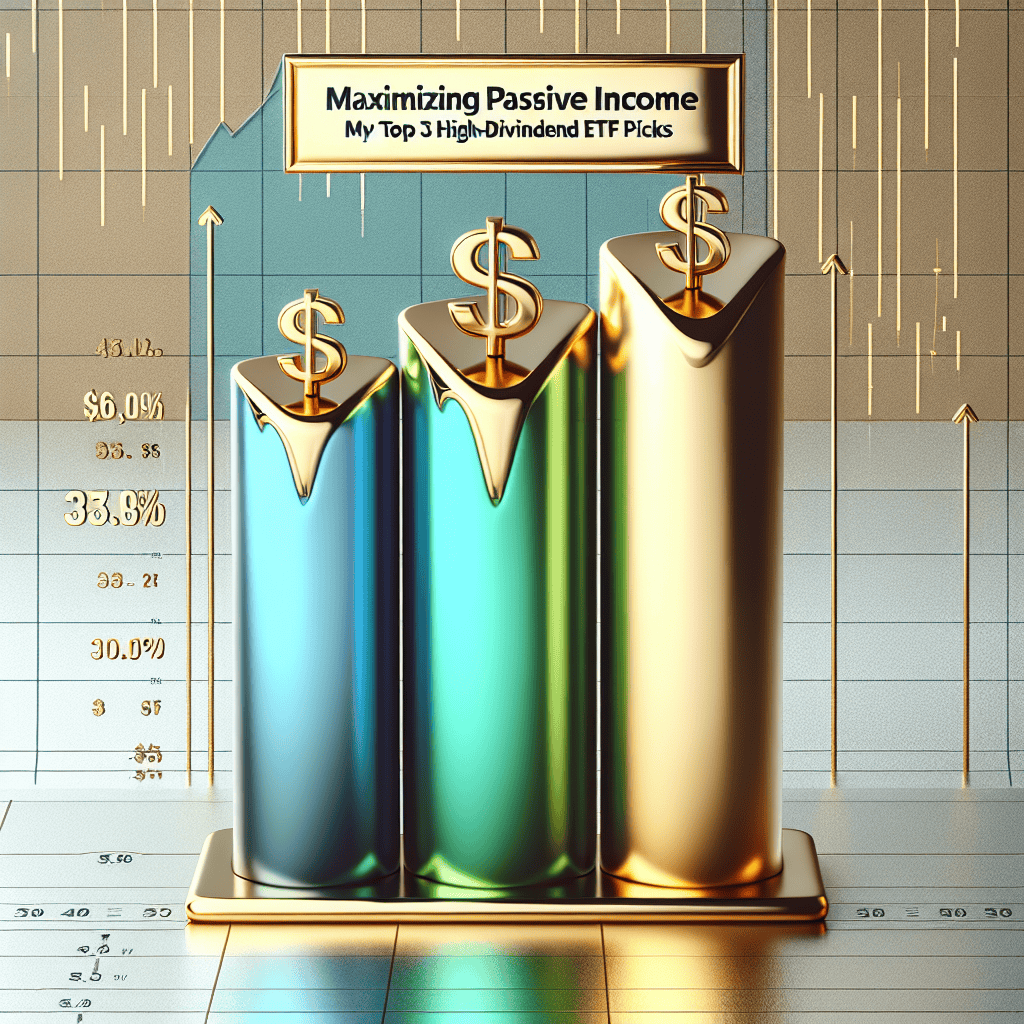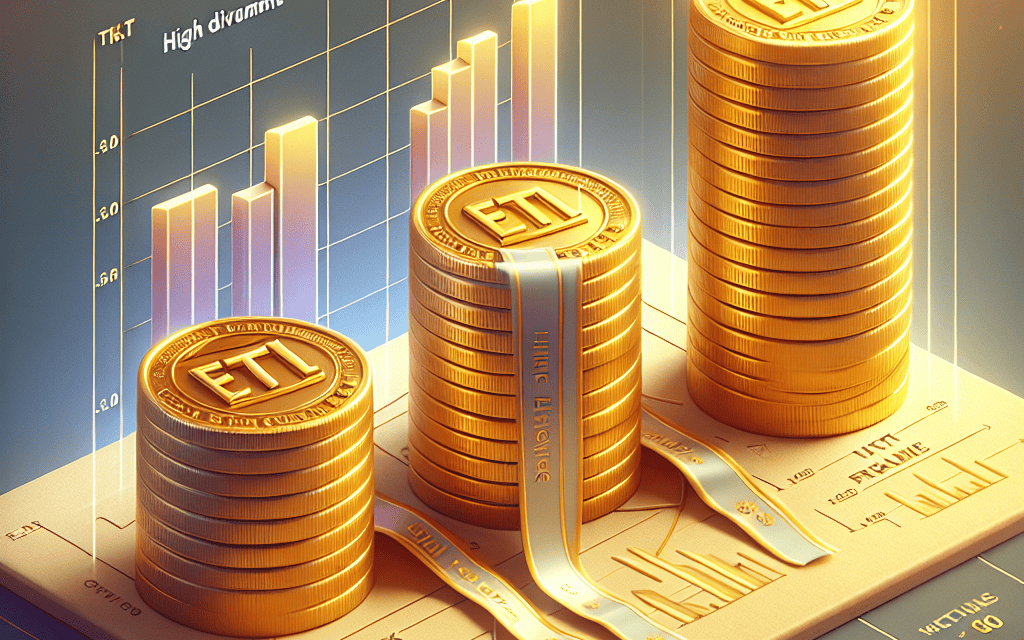“Unlock Financial Freedom: Discover My Top 3 High-Dividend ETF Picks for Maximum Passive Income!”
Introduction
Maximizing passive income is a financial strategy that appeals to many investors seeking to build wealth with minimal effort. One effective way to achieve this is through high-dividend exchange-traded funds (ETFs), which offer the dual benefits of diversification and regular income. These investment vehicles pool together a variety of dividend-paying stocks, providing investors with exposure to a broad range of companies while distributing dividends at regular intervals. In this article, we will explore my top three high-dividend ETF picks, each selected for their strong performance, reliable dividend yields, and potential for long-term growth. These ETFs not only provide a steady stream of income but also offer the opportunity for capital appreciation, making them ideal choices for those looking to enhance their passive income portfolio.
Understanding High-Dividend ETFs: A Path to Passive Income
In the pursuit of financial independence, many investors are drawn to the allure of passive income, a strategy that allows one to earn money with minimal active involvement. Among the various avenues available, high-dividend exchange-traded funds (ETFs) have emerged as a popular choice for those seeking a steady stream of income. These investment vehicles offer the dual benefits of diversification and regular income, making them an attractive option for both novice and seasoned investors. To better understand how high-dividend ETFs can serve as a path to passive income, it is essential to explore some of the top picks in this category.
Firstly, the Vanguard High Dividend Yield ETF (VYM) stands out as a formidable option for income-focused investors. This ETF seeks to track the performance of the FTSE High Dividend Yield Index, which comprises large-cap stocks known for their robust dividend payments. With a low expense ratio, VYM offers investors an efficient way to gain exposure to a broad array of high-yielding companies. The fund’s diversified portfolio includes sectors such as consumer goods, healthcare, and financials, thereby reducing the risk associated with investing in individual stocks. Moreover, Vanguard’s reputation for cost-effective management further enhances the appeal of this ETF, making it a cornerstone for those aiming to maximize passive income.
Transitioning to another noteworthy option, the iShares Select Dividend ETF (DVY) provides a compelling alternative for dividend-seeking investors. This ETF focuses on U.S. companies with a consistent history of dividend payments, thereby offering a reliable income stream. By tracking the Dow Jones U.S. Select Dividend Index, DVY ensures that its holdings are not only high-yielding but also financially stable. The fund’s emphasis on quality is evident in its selection criteria, which include factors such as dividend growth and payout ratios. As a result, investors can benefit from both income and potential capital appreciation, making DVY a well-rounded choice for those looking to bolster their passive income strategy.
In addition to VYM and DVY, the Schwab U.S. Dividend Equity ETF (SCHD) deserves consideration for its unique approach to dividend investing. SCHD tracks the Dow Jones U.S. Dividend 100 Index, which focuses on companies with strong financial health and a history of consistent dividend payments. What sets SCHD apart is its emphasis on total return, combining dividend income with potential capital gains. This strategy not only provides a steady income stream but also offers the possibility of long-term growth. Furthermore, with a competitive expense ratio, SCHD ensures that investors retain more of their returns, enhancing the overall appeal of this ETF.
In conclusion, high-dividend ETFs offer a viable path to passive income, providing investors with a diversified and efficient means of generating regular cash flow. By considering options such as the Vanguard High Dividend Yield ETF, iShares Select Dividend ETF, and Schwab U.S. Dividend Equity ETF, individuals can tailor their investment strategy to align with their financial goals. Each of these ETFs brings unique strengths to the table, whether it be low costs, a focus on quality, or a blend of income and growth. As investors seek to maximize their passive income, understanding the nuances of these high-dividend ETFs can pave the way for a more secure financial future.
Criteria for Selecting High-Dividend ETFs
When considering the selection of high-dividend ETFs to maximize passive income, it is essential to establish a set of criteria that ensures both stability and growth potential. The first criterion to consider is the dividend yield, which is a critical factor for income-focused investors. A high dividend yield indicates that the ETF is capable of providing substantial income relative to its price. However, it is important to balance yield with risk, as excessively high yields may signal underlying issues with the ETF’s holdings. Therefore, a thorough analysis of the yield in relation to the market average and the ETF’s historical performance is necessary.
In addition to dividend yield, the second criterion involves assessing the ETF’s underlying assets. The quality and diversity of the holdings play a significant role in the ETF’s ability to sustain and grow its dividend payouts. An ETF with a well-diversified portfolio across various sectors and industries is generally more resilient to market fluctuations. This diversification helps mitigate risks associated with sector-specific downturns, thereby providing a more stable income stream. Furthermore, examining the financial health and dividend history of the companies within the ETF can offer insights into the sustainability of the dividends. Companies with a strong track record of consistent dividend payments and growth are preferable, as they are more likely to continue this trend in the future.
The third criterion to consider is the expense ratio of the ETF. While it may seem less directly related to dividend income, the expense ratio can significantly impact overall returns. A lower expense ratio means that a smaller portion of the ETF’s returns is consumed by management fees, leaving more income for the investor. It is crucial to compare the expense ratios of similar high-dividend ETFs to ensure that the chosen fund offers competitive costs without compromising on quality. Additionally, understanding the management style and strategy of the ETF can provide further clarity on how effectively the fund is managed, which in turn affects its performance and income potential.
Transitioning from criteria to specific ETF recommendations, it is important to highlight that these selections are based on a comprehensive evaluation of the aforementioned factors. The first ETF to consider is the Vanguard High Dividend Yield ETF (VYM), which offers a robust dividend yield coupled with a low expense ratio. VYM’s portfolio is well-diversified, featuring a mix of large-cap companies with a history of stable dividend payments. This combination makes it an attractive option for investors seeking reliable income.
Next, the Schwab U.S. Dividend Equity ETF (SCHD) stands out due to its focus on quality companies with strong dividend growth. SCHD’s selection criteria emphasize financial strength and dividend sustainability, resulting in a portfolio that balances yield with long-term growth potential. Its competitive expense ratio further enhances its appeal as a cost-effective choice for income-focused investors.
Finally, the iShares Select Dividend ETF (DVY) offers a unique approach by targeting companies with a consistent dividend payment history. DVY’s strategy prioritizes firms with a proven ability to generate income, making it a solid option for those seeking stability. Its diversified holdings across various sectors provide an additional layer of security against market volatility.
In conclusion, selecting high-dividend ETFs requires careful consideration of dividend yield, asset quality, and expense ratios. By focusing on these criteria, investors can identify ETFs that not only offer attractive income but also ensure long-term sustainability and growth.
Analyzing the Performance of Top High-Dividend ETFs
In the quest for financial independence, maximizing passive income through high-dividend exchange-traded funds (ETFs) has become an increasingly popular strategy among investors. These financial instruments offer a diversified approach to income generation, providing exposure to a broad range of dividend-paying stocks. As we delve into the performance of top high-dividend ETFs, it is essential to consider factors such as yield, expense ratio, and historical performance. By doing so, investors can make informed decisions that align with their financial goals.
One of the standout performers in the realm of high-dividend ETFs is the Vanguard High Dividend Yield ETF (VYM). This ETF seeks to track the performance of the FTSE High Dividend Yield Index, which comprises stocks characterized by above-average dividend yields. VYM’s appeal lies in its low expense ratio, which is a hallmark of Vanguard’s offerings, allowing investors to retain more of their returns. Furthermore, VYM’s diversified portfolio includes a mix of sectors, with significant allocations in financials, healthcare, and consumer goods. This diversification not only mitigates risk but also positions the ETF to capitalize on various economic conditions. Over the past decade, VYM has consistently delivered robust returns, making it a reliable choice for those seeking steady income.
Transitioning to another noteworthy option, the iShares Select Dividend ETF (DVY) offers a compelling proposition for income-focused investors. DVY tracks the Dow Jones U.S. Select Dividend Index, which targets companies with a strong track record of dividend payments. What sets DVY apart is its focus on dividend sustainability, ensuring that the companies included have a history of maintaining or increasing their dividends. This focus on quality is reflected in DVY’s performance, as it has demonstrated resilience during market downturns. Additionally, DVY’s sector allocation is skewed towards utilities, consumer staples, and financials, providing a balanced approach to income generation. While its expense ratio is slightly higher than some competitors, the emphasis on dividend reliability justifies the cost for many investors.
Finally, the Schwab U.S. Dividend Equity ETF (SCHD) deserves attention for its impressive performance and cost-effectiveness. SCHD tracks the Dow Jones U.S. Dividend 100 Index, which comprises high-dividend-yielding U.S. stocks with a history of consistent dividend payments. One of SCHD’s key strengths is its low expense ratio, which is among the most competitive in the industry. This cost efficiency, combined with a focus on quality companies, has contributed to SCHD’s strong historical returns. The ETF’s sector allocation is diverse, with significant exposure to information technology, consumer discretionary, and healthcare. This diversification not only enhances potential returns but also provides a buffer against sector-specific volatility.
In conclusion, maximizing passive income through high-dividend ETFs requires careful consideration of various factors, including yield, expense ratio, and historical performance. The Vanguard High Dividend Yield ETF, iShares Select Dividend ETF, and Schwab U.S. Dividend Equity ETF each offer unique advantages that cater to different investor preferences. By analyzing these top-performing ETFs, investors can make informed decisions that align with their financial objectives, ultimately paving the way for a more secure and prosperous financial future. As always, it is crucial for investors to conduct thorough research and consider their risk tolerance before making investment decisions.
Risks and Rewards of Investing in High-Dividend ETFs

Investing in high-dividend exchange-traded funds (ETFs) can be an attractive strategy for those seeking to maximize passive income. These financial instruments offer the dual benefits of diversification and regular income, making them appealing to both novice and seasoned investors. However, like any investment, high-dividend ETFs come with their own set of risks and rewards that must be carefully considered.
To begin with, the primary allure of high-dividend ETFs lies in their ability to generate consistent income streams. By pooling together a variety of dividend-paying stocks, these ETFs provide investors with exposure to a broad range of companies, thereby reducing the risk associated with investing in individual stocks. This diversification is particularly beneficial in volatile markets, where the performance of individual companies can be unpredictable. Moreover, high-dividend ETFs often focus on established companies with a history of stable earnings and reliable dividend payments, which can further enhance the stability of returns.
However, it is crucial to recognize that the pursuit of high dividends can sometimes lead to increased risk. Companies that offer high dividend yields may do so because they are in mature industries with limited growth prospects, or they may be experiencing financial difficulties that make their high yields unsustainable in the long term. Consequently, investors must conduct thorough research to ensure that the high yields are not indicative of underlying financial instability. Additionally, high-dividend ETFs may be more sensitive to interest rate fluctuations. As interest rates rise, the relative attractiveness of dividend-paying stocks may diminish, potentially leading to a decline in the value of the ETF.
Despite these risks, the rewards of investing in high-dividend ETFs can be substantial, particularly for those focused on generating passive income. The regular income provided by these ETFs can be reinvested to compound returns over time, or it can be used to supplement other income sources, such as retirement savings. Furthermore, high-dividend ETFs can offer tax advantages, as qualified dividends are often taxed at a lower rate than ordinary income. This can enhance the overall return on investment, making high-dividend ETFs a tax-efficient choice for income-focused investors.
In addition to the financial benefits, high-dividend ETFs can also provide a sense of financial security. The regular income they generate can help investors weather economic downturns and market volatility, providing a buffer against unexpected expenses or fluctuations in other income sources. This stability can be particularly appealing to retirees or those nearing retirement, who may prioritize income generation over capital appreciation.
In conclusion, while investing in high-dividend ETFs presents certain risks, the potential rewards can make them a valuable component of a diversified investment portfolio. By carefully selecting ETFs with a strong track record of dividend payments and financial stability, investors can maximize their passive income while mitigating potential downsides. As with any investment decision, it is essential to conduct thorough research and consider one’s individual financial goals and risk tolerance. By doing so, investors can harness the power of high-dividend ETFs to achieve their income objectives and enhance their overall financial well-being.
Diversifying Your Portfolio with High-Dividend ETFs
In the ever-evolving landscape of investment opportunities, diversifying your portfolio with high-dividend exchange-traded funds (ETFs) has emerged as a compelling strategy for maximizing passive income. As investors seek to balance risk and reward, high-dividend ETFs offer a unique blend of income generation and potential capital appreciation. By focusing on ETFs that prioritize dividend yields, investors can enjoy a steady stream of income while benefiting from the diversification inherent in these funds. In this context, I present my top three high-dividend ETF picks that can serve as valuable additions to any investment portfolio.
To begin with, the Vanguard High Dividend Yield ETF (VYM) stands out as a robust option for those seeking consistent income. This ETF tracks the performance of the FTSE High Dividend Yield Index, which comprises companies characterized by above-average dividend yields. With a diverse array of holdings across various sectors, VYM offers investors exposure to a broad spectrum of industries, thereby mitigating sector-specific risks. Moreover, Vanguard’s reputation for low expense ratios ensures that investors retain a larger portion of their returns, making VYM an attractive choice for long-term income generation.
Transitioning to another noteworthy option, the iShares Select Dividend ETF (DVY) provides a compelling alternative for income-focused investors. This ETF tracks the Dow Jones U.S. Select Dividend Index, which includes companies with a consistent history of dividend payments. By emphasizing dividend sustainability and growth, DVY offers a reliable income stream while also providing potential for capital appreciation. Furthermore, the fund’s diversified holdings across utilities, consumer goods, and financial sectors contribute to its resilience in varying market conditions. As a result, DVY is well-suited for investors seeking both stability and income growth.
In addition to VYM and DVY, the SPDR S&P Dividend ETF (SDY) deserves consideration for its unique approach to dividend investing. SDY tracks the S&P High Yield Dividend Aristocrats Index, which focuses on companies that have consistently increased their dividends for at least 20 consecutive years. This emphasis on dividend growth not only ensures a reliable income stream but also signals the financial health and stability of the underlying companies. By investing in SDY, investors gain exposure to a portfolio of high-quality, dividend-paying stocks that have demonstrated resilience through various economic cycles. Consequently, SDY offers a compelling combination of income and growth potential.
In conclusion, diversifying your portfolio with high-dividend ETFs can be an effective strategy for maximizing passive income while managing risk. The Vanguard High Dividend Yield ETF, iShares Select Dividend ETF, and SPDR S&P Dividend ETF each offer unique advantages that cater to different investment preferences. By incorporating these ETFs into a diversified portfolio, investors can enjoy the benefits of steady income, potential capital appreciation, and reduced volatility. As with any investment decision, it is crucial to conduct thorough research and consider individual financial goals and risk tolerance. However, by focusing on high-dividend ETFs, investors can position themselves to achieve a balanced and rewarding investment experience.
Tax Implications of High-Dividend ETF Investments
When considering high-dividend ETFs as a strategy for maximizing passive income, it is crucial to understand the tax implications associated with these investments. High-dividend ETFs, which are exchange-traded funds that focus on stocks offering substantial dividend yields, can be an attractive option for investors seeking regular income. However, the tax treatment of dividends can significantly impact the net returns from these investments. Therefore, a comprehensive understanding of the tax landscape is essential for making informed decisions.
To begin with, dividends received from high-dividend ETFs are typically classified into two categories: qualified and non-qualified dividends. Qualified dividends are taxed at the long-term capital gains tax rate, which is generally lower than the ordinary income tax rate. To qualify, the dividends must be paid by a U.S. corporation or a qualified foreign corporation, and the investor must meet specific holding period requirements. On the other hand, non-qualified dividends are taxed at the investor’s ordinary income tax rate, which can be substantially higher. This distinction is crucial because it directly affects the after-tax income an investor receives from their ETF holdings.
Moreover, the structure of the ETF itself can influence the tax treatment of dividends. For instance, some ETFs are structured as regulated investment companies (RICs), which are required to distribute at least 90% of their taxable income to shareholders. This distribution is then passed through to investors, who must report it on their tax returns. In contrast, other ETFs may be structured as grantor trusts or partnerships, each with its own unique tax implications. Understanding the specific structure of an ETF can help investors anticipate the tax consequences of their investment.
In addition to the classification of dividends, investors should also be aware of the potential impact of state and local taxes. While federal tax rates on dividends are relatively straightforward, state and local taxes can vary significantly. Some states may offer favorable tax treatment for dividends, while others may impose additional taxes. Therefore, investors should consider their specific tax situation, including their state of residence, when evaluating the potential after-tax returns of high-dividend ETFs.
Furthermore, tax-advantaged accounts such as IRAs and 401(k)s can play a significant role in managing the tax implications of high-dividend ETF investments. By holding these ETFs in a tax-deferred account, investors can potentially defer taxes on dividends until they withdraw funds in retirement. This strategy can be particularly beneficial for investors in higher tax brackets, as it allows them to take advantage of compounding returns without the immediate tax burden. However, it is important to note that withdrawals from these accounts are typically taxed as ordinary income, which may offset some of the tax benefits.
In conclusion, while high-dividend ETFs can be an effective tool for generating passive income, understanding the tax implications is essential for maximizing net returns. By considering factors such as the classification of dividends, the structure of the ETF, state and local taxes, and the use of tax-advantaged accounts, investors can make more informed decisions and optimize their investment strategy. As with any investment, consulting with a tax professional or financial advisor can provide valuable insights tailored to an individual’s specific circumstances, ensuring that the pursuit of passive income aligns with broader financial goals.
Long-Term Strategies for Maximizing Returns with High-Dividend ETFs
In the pursuit of financial independence, maximizing passive income through strategic investments is a goal shared by many. High-dividend exchange-traded funds (ETFs) have emerged as a popular choice for investors seeking to enhance their income streams while maintaining a diversified portfolio. These ETFs offer the dual benefits of regular income through dividends and the potential for capital appreciation. As such, they are an attractive option for those looking to build a sustainable, long-term investment strategy. In this context, I present my top three high-dividend ETF picks that can serve as a cornerstone for maximizing returns.
First on the list is the Vanguard High Dividend Yield ETF (VYM). This ETF is renowned for its broad exposure to U.S. companies that consistently pay above-average dividends. By focusing on large-cap stocks, VYM provides investors with a stable and reliable income stream. The fund’s diversified portfolio includes sectors such as consumer goods, healthcare, and financials, which are known for their resilience and ability to generate steady cash flows. Moreover, Vanguard’s reputation for low expense ratios ensures that investors can maximize their returns without incurring significant costs. Consequently, VYM is an excellent choice for those seeking a balance between income and growth potential.
Transitioning to international markets, the iShares International Select Dividend ETF (IDV) offers exposure to high-dividend-paying companies outside the United States. This ETF is particularly appealing for investors looking to diversify their income sources geographically. IDV focuses on developed markets, including Europe, Asia, and Australia, providing a hedge against domestic market volatility. The fund’s emphasis on sectors such as utilities, telecommunications, and energy ensures a steady dividend yield, even in uncertain economic climates. Additionally, the inclusion of international stocks can offer currency diversification, which may further enhance returns. Therefore, IDV is a compelling option for those aiming to broaden their investment horizons while maintaining a focus on high dividends.
Finally, the Schwab U.S. Dividend Equity ETF (SCHD) stands out for its strategic approach to dividend investing. SCHD targets U.S. companies with a strong track record of dividend payments and robust financial health. The ETF employs a rigorous selection process, focusing on metrics such as dividend yield, dividend growth rate, and return on equity. This disciplined approach results in a portfolio of high-quality stocks that not only provide attractive dividend yields but also exhibit potential for capital appreciation. Furthermore, SCHD’s low expense ratio makes it an efficient vehicle for long-term investors seeking to maximize their passive income. As a result, SCHD is an ideal choice for those who prioritize both income stability and growth.
In conclusion, high-dividend ETFs offer a viable path for investors aiming to maximize passive income while maintaining a diversified portfolio. The Vanguard High Dividend Yield ETF, iShares International Select Dividend ETF, and Schwab U.S. Dividend Equity ETF each present unique advantages that cater to different investment preferences and risk appetites. By incorporating these ETFs into a long-term investment strategy, investors can achieve a balanced approach that combines regular income with the potential for capital growth. As always, it is essential to conduct thorough research and consider individual financial goals before making investment decisions. Nevertheless, these high-dividend ETFs provide a solid foundation for those seeking to enhance their passive income streams and secure their financial future.
Q&A
1. **What is a high-dividend ETF?**
A high-dividend ETF is an exchange-traded fund that focuses on investing in stocks that pay above-average dividends, providing investors with regular income.
2. **Why are high-dividend ETFs popular for passive income?**
They offer a way to earn regular income without actively managing individual stocks, making them attractive for investors seeking steady cash flow.
3. **What is one top high-dividend ETF pick for maximizing passive income?**
Vanguard High Dividend Yield ETF (VYM) is a popular choice due to its diversified portfolio of high-yielding stocks and low expense ratio.
4. **What is another recommended high-dividend ETF?**
iShares Select Dividend ETF (DVY) is favored for its focus on U.S. companies with a consistent history of paying dividends.
5. **What is a third high-dividend ETF to consider?**
SPDR S&P Dividend ETF (SDY) is notable for its strategy of investing in companies that have increased dividends for at least 20 consecutive years.
6. **What are the benefits of investing in high-dividend ETFs?**
They provide diversification, regular income, and potential for capital appreciation, with less volatility compared to individual stocks.
7. **What should investors consider when choosing a high-dividend ETF?**
Investors should consider the ETF’s expense ratio, dividend yield, historical performance, and the underlying index it tracks.
Conclusion
Maximizing passive income through high-dividend ETFs can be an effective strategy for investors seeking regular income with potential for capital appreciation. By selecting ETFs with a strong track record of dividend payments, low expense ratios, and diversified holdings, investors can enhance their income streams while mitigating risk. My top three high-dividend ETF picks offer a balanced approach, combining stability with growth potential. These ETFs not only provide attractive yields but also align with long-term financial goals, making them suitable for both conservative and growth-oriented portfolios. Ultimately, careful selection and periodic review of these ETFs can help investors achieve a sustainable and growing passive income stream.





